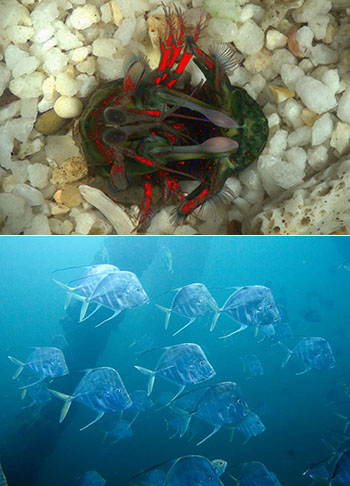
Mantis shrimp (top) can detect patterns of circularly polarized reflections (red color) to determine whether a seabed refuge is already occupied by a potentially aggressive competitor. [Image: Yakir Gagnon/QBI] Meanwhile, selected fish species such as the lookdown (bottom) apparently have evolved skin platelets that can manipulate polarized light for camouflage in the open ocean. [Image: Erich Schlegel]
Humans have used polarization, a fundamental property of electromagnetic waves such as light, in a wide variety of ways, ranging from sunglasses to the multiplexing of signals in optical communications. Now, work by several different research teams has highlighted some ingenious uses of polarization that have evolved over eons in selected marine animals.
Invertebrates: Polarization as communication
Two of the recent studies, by research groups from the United Kingdom and Australia, focused on the uses made of polarized light by several marine crustaceans. One study (Curr. Biol., doi: 10.1016/j.cub.2015.09.073) looked at fiddler crabs, a common group of semi-aquatic invertebrates that live in mudflats, lagoons and other nearshore environments. While it’s been known for some time that these crabs (along with numerous other invertebrates) can detect polarized light, their use of that ability has been obscure and not well limned by lab experiments.
The U.K.-Australian team used imaging polarimetry in the crabs’ natural environment to establish that the crabs’ bodies and large claws generate two types of polarization contrast against the glare-ridden natural background. They further established—through field experiments with remotely activated sled “targets” fitted with films that could generate different varieties of polarization—that the crabs responded to specific patterns in polarization in different ways. The findings suggested that the crabs use polarization contrasts to distinguish among potential predators, competitors, and mates. “It is becoming increasingly evident,” concludes the paper, “that animals may use polarization reflections in the same way as color.”
A second study (Curr. Biol., doi: 10.1016/j.cub.2015.10.047) that included some members of the same U.K.-Australian research group zeroed in on another marine crustacean, the mantis shrimp. One of the many remarkable characteristics of these solitary seabed creatures is their ability, discovered a number of years ago, to discriminate circularly polarized light—an ability unique in the animal kingdom, according to the team.
In the new study, the researchers, focusing on the mantis shrimp species Gonodactylaceus falcatus, established that the shrimp not only can distinguish circularly polarized light, but that they actually display circularly polarized patterns on their bodies, especially on their legs, head, and tail, in much the same way that other animals use color markings.
The team then set up a tank with multiple burrows that the shrimp could use for shelter, some of them with circularly polarized patterns similar to those displayed by the shrimp and some with an unpolarized pattern. The researchers found that the shrimp chose the unpolarized burrows 68 percent of the time. That, says the team, suggests that the shrimp may use circularly polarized light as a covert signal that a burrow is already occupied by another mantis shrimp, thereby avoiding a potentially nasty confrontation with another animal when seeking a refuge on the seafloor.
Open-ocean fish: Polarization for invisibility
A separate study by U.S. researchers explored the use of polarization as an aid to camouflage (Science, doi: 10.1126/science.aad5284). Here, the researchers sought to solve the mystery of how schools of fish can effectively disappear from predators in the open ocean, despite the lack of material to hide behind.
The answer, again, seems to lie in manipulation of polarization. The open ocean offers a complex, changing light field characterized by polarized light, with the specifics of the polarization changing in ways that vary with the sun’s position in the sky. Not surprisingly, many open-ocean fish have thus evolved the ability to sense polarization—and, indeed, polarization contrasts tend to be more effective for open-ocean detection than brightness or color contrasts.
In the new study, researchers from several U.S. institutions wanted to investigate whether fish might manipulate polarization patterns to “hide in plain sight” in the open ocean. To determine this, they created a video polarimeter that could detect changes in polarization in real time, and an automated rotating platform on which the instrument could be mounted to detect the polarization coming off of schools of captive fish. They then took more than 1,500 polarimetry measurements for five fish species under a variety of conditions, times of day, and sun heights.
The team found that the two species of open-ocean fish studied, the lookdown and the bigeye scad, had much lower polarization contrast with the background environment—and, hence, better camouflage in polarized light—than two reef-dwelling fish and one surface-skimming fish, all of which live in environments where polarized light is not as important. Moreover, the camouflage was particularly effective at so-called chase angles, the directions from which a predator might pursue the fish.
The fish have apparently evolved this ability through guanine platelets in the fish’s skin that have been shaped by natural selection to produce angle-dependent polarized reflections. As a next step in the research, the team will investigate whether the fish can actively manipulate this ability to adjust for changes in polarization conditions in the wild.
